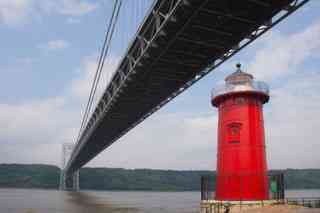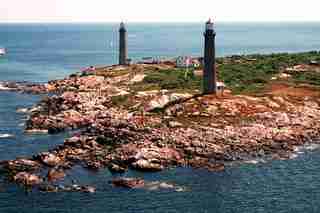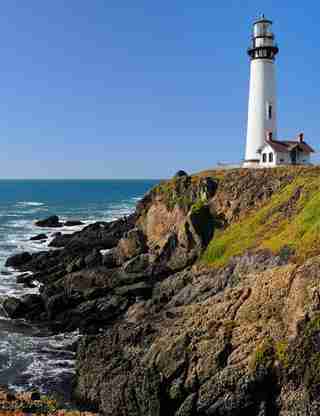
Jeffrey's Hook Lighthouse
Originally built in 1880 in Sandy Hook, New Jersey, in 1921 Jeffrey’s Hook Lighthouse was moved to its current location in upper Manhattan to improve navigation along the Hudson River. Nicknamed the Little Red Lighthouse, it served as an essential guide for the next decade, until the lights on the George Washington Bridge, completed in 1931, overwhelmed the 40-foot tower and eventually led to its removal from service in 1947. The Coast Guard later planned to auction it off, but that effort was halted, thanks in part to a public outcry prompted by a 1942 children’s book, The Little Red Lighthouse and the Great Gray Bridge by Hildegarde Swift, that captured the hearts of many. In 1979 it was added to the National Register of Historic Places, and today it is one of the few remaining lighthouses in New York City.

Thacher Island Twin Lights
In the early 1700s a dangerous reef off the coast of Rockport, Massachusetts, was the site of hundreds of shipwrecks, earning it the nickname Londoner Ledge, because many of the sunken vessels had been en route to Boston from London. As a result, John Hancock petitioned for lighthouses to be constructed on nearby Thacher Island . The original 45-foot-tall wood-and-stone structures, erected in 1771, were the last to be built under British rule. They were replaced in 1861 by a pair of identical 124-foot granite towers, which appear on the town of Rockport’s official seal. Today they are the only active twin lighthouses in the United States.

Pigeon Point Lighthouse
Perched on a picturesque cliff 50 miles south of San Francisco, Pigeon Point Lighthouse was first lit in November 1872. Named after the Carrier Pigeon vessel that wrecked nearby in 1853, it stands 115 feet tall, matching Point Arena Lighthouse in Mendocino County as the tallest along the Pacific coast. It serves as the original logo for American media conglomerate E. W. Scripps Company , whose motto is “Give light and the people will find their own way." Pigeon Point Lighthouse is currently closed for restoration, a project that was initiated after large sections of the cornice came tumbling down in December 2001. Visitors can still explore the grounds and stay in the lighthouse keeper’s quarters, which have been converted into a hostel .
Southwest Reef Light
The square pyramidal Southwest Reef Light has rested on the banks of the Berwick Bay in Berwick, Louisiana, since 1987. However, it spent most of its life 25 miles downstream in the Atchafalaya Bay, where it began operations in 1858. Three years after it was erected, Confederate soldiers removed the light from service, and it remained dark throughout the Civil War, until Union forces reinstated it, six years to the day of when it was first lit. It was permanently deactivated in 1916, and it was added to the National Register of Historic Places in 1991.
Cape Hatteras Light
An iconic symbol of North Carolina’s Outer Banks, the 208-foot Cape Hatteras Light is the tallest lighthouse in the United States and one of the tallest in the world. The original 1803 tower was erected to warn ships of the Diamond Shoals, deemed one of the most perilous stretches of shallow sandbars along the Atlantic coast. Over the years, the light underwent improvements and was eventually reconstructed in 1870. Its famous daymark pattern of black-and-white spiral striping (hence its nickname the Big Barber Pole) was added three years later so that mariners could distinguish it from other lighthouses in the area. Due to massive beach erosion, in 1999 the light and its accompanying quarters were moved and now sit 1,500 feet inland.
West Quoddy Head Light
The site of West Quoddy Head Light, on the Bay of Fundy in Lubec, Maine, is famously the easternmost point in the United States. Congress put up $5,000 for the first wooden station in 1806, which has been rebuilt twice since it opened in 1808. The current tower, completed in 1858, stands at only 49 feet high, but it has a striking presence thanks to its red-and-white stripes. Still actively used by the Coast Guard, the beacon is now part of Quoddy Head State Park and is open to visitors on September 15, as part of the annual Maine Open Lighthouse Day festivities.
Split Rock Lighthouse
Perched on a 130-foot cliff overlooking Lake Superior, near the town of Two Harbors, Minnesota, the iconic Split Rock Lighthouse is as postcard-worthy as they come. The octagonal structure, designed by engineer Ralph Russell Tinkham and completed in 1910, was built in response to the Mataafa Storm of 1905, which destroyed 29 ships on the lake. Although the Coast Guard deactivated the light in 1969, it is relit each year on November 10 to commemorate the 29 crew members who lost their lives when the SS Edmund Fitzgerald freighter sank on that date in 1975.
Montauk Point Lighthouse
The Montauk Point Lighthouse at the eastern tip of Long Island has a significant place in maritime history as the oldest lighthouse in New York and the United States’ first public works project sanctioned by President George Washington and the Second Congress in 1792. When the tower, designed by architect John McComb, was completed in 1796, it stood 300 feet from the Turtle Hill bluff, but due to erosion, it is now less than 100 feet from the edge. Distinguished by a single brown stripe, the 110-foot sandstone tower now serves as a striking backdrop to many weddings and events. Earlier this year it was designated a National Historic Landmark.
Heceta Head Lighthouse
Named after Spanish Royal Navy Commander Don Bruno de Heceta, who surveyed the Pacific Northwest during an expedition in the late 1700s, Heceta Head Lighthouse is situated on a spectacular 205-foot bluff, one of the most frequently photographed points on the Oregon coast. The assistant lightkeeper’s house, which was constructed in 1893, at the same time as the 56-foot-tall lighthouse, is now a popular six-room bed and breakfast . The lighthouse is currently undergoing a $1.3 million renovation, a project that is slated for completion in August 2013.
Big Sable Point Lighthouse
Commerce was the driving force behind the Big Sable Point Lighthouse in Mason County, Michigan, which guided vessels carrying lumber along the hazardous eastern shore of Lake Michigan. The 1867 tower was originally constructed using Cream City brick, which drastically deteriorated over the next 30 years. Instead of completely rebuilding the lighthouse, in 1900 steel plates were added to the exterior—later painted white with a black band—giving the landmark its distinctive look. Today the Sable Points Lighthouse Keepers Association maintains the beacon, along with two others nearby.
Hudson-Athens Lighthouse
Sited on a granite foundation in the middle of the Hudson River, between the towns of Hudson and Athens, this New York lighthouse was built in 1874 to guide ships around the Middle Ground Flats, a sandy ridge that stranded many vessels midstream. Due to its isolated location in the water, the two-story, Second Empire–style structure included living quarters for the keeper and his (or, in one instance, her) family. While the Coast Guard still manages the beacon, the Hudson-Athens Lighthouse Preservation Society maintains the property and has restored it to its 1930s glory, when Emil J. Brunner—whose child was born at the site—was the keeper.
Castle Hill Lighthouse
Built into a rocky bluff in Newport, Rhode Island, the ruggedly beautiful Castle Hill Light melds seamlessly into its setting. H. H. Richardson, the American architect best known for Boston’s Trinity Church and his Richardsonian Romanesque style, was responsible for the design. It was built in 1890 on a piece of land that had belonged to Harvard marine biologist Alexander Agassiz, who sold it to the U.S. government for one dollar. Agassiz’s summer residence is now the famous Castle Hill Inn , whose guests can use walking trails to reach the lighthouse, even though it is not open to the public. The tower remains a starting point for many Newport regattas and is an ideal viewing point for the races.
Point Bolivar Lighthouse
Built in 1872 in Port Bolivar, Texas, and in operation until 1933, the Point Bolivar Lighthouse was actually the second light to be constructed on the site, after the first was completely disassembled during the Civil War by Confederate troops, who supposedly used its iron parts to produce artillery. The current structure made headlines in 1900, and again in 1915, when it withstood two of the worst storms ever recorded on the Gulf Coast and provided refuge for local residents. The 117-foot-tall tower’s original black-and-white striped daymark pattern rusted over time, giving it a distinctive all-black facade.
Sankaty Head Lighthouse
Once an international whaling capital, the island of Nantucket, off Cape Cod, Massachusetts, is home to Sankaty Head Lighthouse, which was built in 1850 in the town of Siasconset to warn incoming ships of the dangerous shoals off the island’s southeastern shore. In 1987 the lighthouse was added to the National Register of Historic Places, and in 2007 it was moved 400 feet from its original location, after erosion had brought the cliff edge within 76 feet. The tower now overlooks the fifth hole of the Sankaty Head Golf Course and remains one of Nantucket’s most prominent landmarks.
